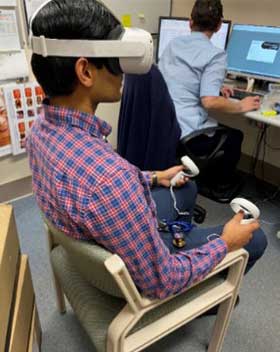Virtual reality is proving to be a successful training method to implement the NSW Telestroke Service in rural and regional hospitals across the state.
“The NSW Telestroke Service provides 24/7 access to lifesaving stroke diagnosis and treatment,” explains Courtney Dixon, the ACI’s Telestroke Implementation Manager.
“The service connects local emergency doctors to specialist stroke physicians using video consultation. High-quality brain imaging also shows where the stroke is and its impact.
“Staff training is a key part of working with each hospital to implement the service. It improves staff understanding of, and confidence with, the acute stroke management process.”
The Agency for Clinical Innovation (ACI) has partnered with the Centre for Advanced Training Systems at the University of Newcastle to develop the innovative training, using a virtual reality platform called TACTICS VR. The Hunter New England Local Health District Stroke Research Network also contributed to the project. The platform and headsets are part of a comprehensive education package provided by the ACI, Prince of Wales Hospital and eHealth NSW.

Clinician using the virtual reality
training program.
“Virtual reality provides an opportunity for staff to train in a realistic environment before they need to treat patients or use new systems in the real world,” explains Dr Steve Maltby, Project Manager, Centre for Advanced Training Systems. “This is particularly valuable in high-risk scenarios, such as stroke. The training is engaging and interactive, helping to support uptake.”
Developing the training
The ACI’s Stroke Network Manager saw a demonstration of the technology and identified how powerful it would be to train and improve clinical skills in a virtual reality setting that duplicates the emergency department’s environment and time pressures.
Professor Rohan Walker, the Director of the Centre for Advanced Training Systems, was approached to see if virtual reality could be used for telestroke.
“We brought experts together to identify key learning objectives for the training, keeping the specific audience and evidence-based guidelines central to the process,” says Steve.
How the 20-minute virtual reality training works
- When staff put the virtual reality headset on, they are immersed in a stroke case, and need to gather information and make treatment decisions – from arrival at hospital through to stroke assessment, imaging, consent and treatment.
- The noise, movement and distractions of an emergency department are included to train staff in a life-like environment.
- Professor Ken Butcher, NSW Telestroke Service Medical Director, provides guidance on what to expect and the key learning points at each stage.
- If staff make an incorrect assessment or decision, the system provides immediate feedback. This helps train staff to make optimal decisions.
- Throughout the training a clock displays how long it has been since the stroke occurred. It also estimates brain neurons lost as a result of delays. Suboptimal decisions result in time penalties. This trains staff to make accurate and quick decisions for better outcomes.
- Staff receive feedback on their overall performance at the end.
View part of the virtual reality training.
“This type of training is time and resource efficient,” Steve adds. “It is available on-site whenever anyone puts the headset on, at a time convenient to them.”
The virtual reality training has been vital during the COVID-19 pandemic where travel and large staff gatherings have been difficult or impossible. Analytics from the training are also provided to the ACI to inform training improvements and develop future training modules.
What are clinicians saying about the training?
Kim Hoffman, Lismore Stroke Coordinator, says feedback from staff has been positive.
“It’s an engaging form of training that is flexible, allowing clinicians to do the training in their own time while reinforcing the telestroke assessment process,” she explains.
Professor Ken Butcher says the virtual reality training provides a unique opportunity for clinicians. “The training and capacity building for each local site’s medical, nursing, allied health, technical and administrative staff is exemplary,” he says.
Important NSW Telestroke Service facts and stats
- Thirteen NSW Health hospitals across regional and rural NSW are connected to the service. This will expand to up to 23 sites by June 2022.
- The service has treated more than 1,000 patients.
- It is a $21.7 million election commitment, announced in March 2019.
- It is jointly funded by the NSW and Commonwealth Governments.
- Implementation is a collaboration between the ACI, Prince of Wales Hospital (POW), eHealth NSW and the Ministry of Health. POW also hosts the service.
Learn more
- For clinicians: NSW Telestroke Service
- For consumers: NSW Telestroke Service
- Centre for Advanced Training Systems and TACTICS VR.